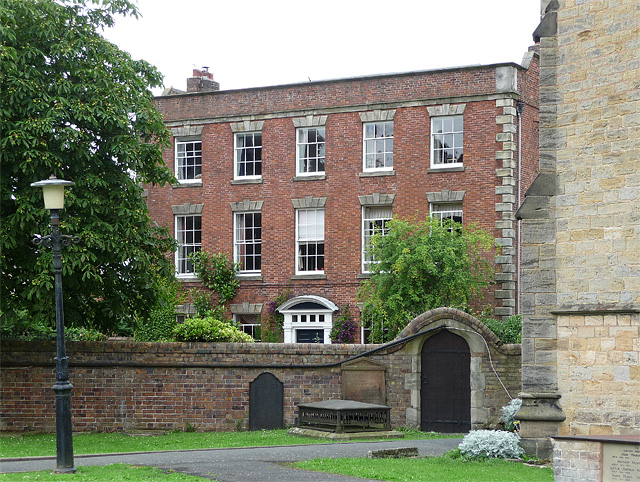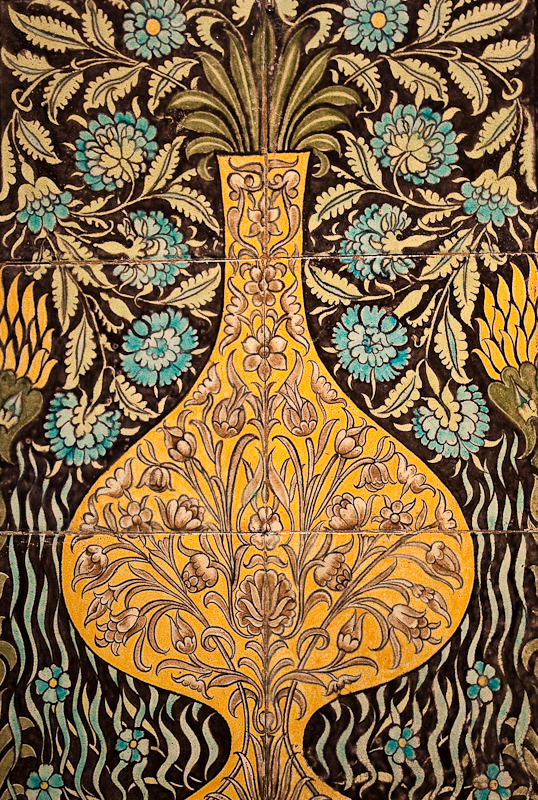|
Jackfield Tile Museum
Jackfield Tile Museum is a museum which presents the history of the British decorative tile industry between 1840 and 1960, the period in which this factory and that of Maw & Co nearby played an important part in this industry. The museum lies in the village of Jackfield, near Broseley, on the south bank of the River Severn in the Ironbridge Gorge, in Shropshire, England. It is located within a World Heritage Site, the birthplace of the Industrial Revolution. It is one of the ten Ironbridge Gorge museums administered by the Ironbridge Gorge Museum Trust. The museum is housed in a decorative tile factory building, the former works of Craven Dunnill and Company, that is still used to produce tiles, particularly encaustic tiles. Jackfield is one of the oldest known ceramic production centres in Shropshire, a tradition dating back to the 16th century. The Thursfield family settled in Jackfield during the early 18th century; Jackfield wares are attributed to the family. Craven D ... [...More Info...] [...Related Items...] OR: [Wikipedia] [Google] [Baidu] |
Jackfield Tile Museum
Jackfield Tile Museum is a museum which presents the history of the British decorative tile industry between 1840 and 1960, the period in which this factory and that of Maw & Co nearby played an important part in this industry. The museum lies in the village of Jackfield, near Broseley, on the south bank of the River Severn in the Ironbridge Gorge, in Shropshire, England. It is located within a World Heritage Site, the birthplace of the Industrial Revolution. It is one of the ten Ironbridge Gorge museums administered by the Ironbridge Gorge Museum Trust. The museum is housed in a decorative tile factory building, the former works of Craven Dunnill and Company, that is still used to produce tiles, particularly encaustic tiles. Jackfield is one of the oldest known ceramic production centres in Shropshire, a tradition dating back to the 16th century. The Thursfield family settled in Jackfield during the early 18th century; Jackfield wares are attributed to the family. Craven D ... [...More Info...] [...Related Items...] OR: [Wikipedia] [Google] [Baidu] |
Craven Dunnill
Craven Dunnill & Co. Ltd. (formerly Hargreaves & Craven, then Hargreaves, Craven Dunnill & Co.) was formed on 9 February 1872, by Yorkshire businessman Henry Powell Dunnill (1821–95), at Jackfield, Shropshire, England. The firm was to become one of Britain's leading producers of ceramic tiles. Expansion Original, early 20th century, Craven Dunnill tiles on the bar of the Golden Cross pub in Cardiff Initially based in old buildings in Jackfield, the firm relocated to a nearby new factory, known as the 'Jackfield Works', on 25 February 1874 (grid reference SJ 686029). Designed by Charles Lynam (1829–1921), an architect from Leek, Staffordshire who specialized in industrial buildings and also worked on Croxden Abbey, Craven Dunnill's Jackfield Works was constructed in the Gothic Revival style with a characteristic 'long and thin' plan, enabling raw clay to enter at one end, and finished products to emerge at the other. Lynam was the architect of two other 19th century Victor ... [...More Info...] [...Related Items...] OR: [Wikipedia] [Google] [Baidu] |
Tiling
{{disambiguation, surname ...
Tiling may refer to: *The physical act of laying tiles *Tessellations Computing *The compiler optimization of loop tiling *Tiled rendering, the process of subdividing an image by regular grid *Tiling window manager People *Heinrich Sylvester Theodor Tiling (1818–1871), physician and botanist *Reinhold Tiling (1893–1933), German rocket pioneer Other uses *Neuronal tiling *Tile drainage, an agriculture practice that removes excess water from soil *Tiling (crater), a small, undistinguished crater on the far side of the Moon See also *Brickwork *Packing (other) *Tiling puzzle Tiling puzzles are puzzles involving two-dimensional packing problems in which a number of flat shapes have to be assembled into a larger given shape without overlaps (and often without gaps). Some tiling puzzles ask you to dissect a given ... [...More Info...] [...Related Items...] OR: [Wikipedia] [Google] [Baidu] |
Ceramics Museums In The United Kingdom
A ceramic is any of the various hard, brittle, heat-resistant and corrosion-resistant materials made by shaping and then firing an inorganic, nonmetallic material, such as clay, at a high temperature. Common examples are earthenware, porcelain, and brick. The earliest ceramics made by humans were pottery objects (''pots,'' ''vessels or vases'') or figurines made from clay, either by itself or mixed with other materials like silica, hardened and sintered in fire. Later, ceramics were glazed and fired to create smooth, colored surfaces, decreasing porosity through the use of glassy, amorphous ceramic coatings on top of the crystalline ceramic substrates. Ceramics now include domestic, industrial and building products, as well as a wide range of materials developed for use in advanced ceramic engineering, such as in semiconductors. The word "''ceramic''" comes from the Greek word (), "of pottery" or "for pottery", from (), "potter's clay, tile, pottery". The earliest known m ... [...More Info...] [...Related Items...] OR: [Wikipedia] [Google] [Baidu] |
History Of Shropshire
Shropshire was established during the division of Saxon Mercia into shires in the 10th century. It is first mentioned in 1006. After the Norman Conquest it experienced significant development, following the granting of the principal estates of the county to eminent Normans, such as Roger De Montgomery and his son Robert de Bellême. The Coalbrookdale area of the county is designated "the birthplace of the Industrial Revolution", due to significant technological developments that happened there. Etymology The origin of the name "Shropshire" is the Old English "Scrobbesbyrigscīr" (literally ''Shrewsburyshire''), perhaps taking its name from Richard Scrob (or FitzScrob or Scrope), the builder of Richard's Castle near what is now the town of Ludlow. However, the Normans who ruled England after 1066 found both "Scrobbesbyrig" and "Scrobbesbyrigscir" difficult to pronounce so they softened them to "Salopesberia" and "Salopescira". Salop is the abbreviation of these. When a council ... [...More Info...] [...Related Items...] OR: [Wikipedia] [Google] [Baidu] |
Decorative Arts Museums In England
Beauty is commonly described as a feature of objects that makes these objects pleasurable to perceive. Such objects include landscapes, sunsets, humans and works of art. Beauty, together with art and taste, is the main subject of aesthetics, one of the major branches of philosophy. As a positive aesthetic value, it is contrasted with ugliness as its negative counterpart. Along with truth and goodness it is one of the transcendentals, which are often considered the three fundamental concepts of human understanding. One difficulty in understanding beauty is because it has both objective and subjective aspects: it is seen as a property of things but also as depending on the emotional response of observers. Because of its subjective side, beauty is said to be "in the eye of the beholder". It has been argued that the ability on the side of the subject needed to perceive and judge beauty, sometimes referred to as the "sense of taste", can be trained and that the verdicts of experts ... [...More Info...] [...Related Items...] OR: [Wikipedia] [Google] [Baidu] |
Industry Museums In England
Industry may refer to: Economics * Industry (economics), a generally categorized branch of economic activity * Industry (manufacturing), a specific branch of economic activity, typically in factories with machinery * The wider industrial sector of an economy, including manufacturing and production of other intermediate or final goods * The general characteristics and production methods common to an industrial society ** Industrialization, the transformation into an industrial society * Industry classification, a classification of economic organizations and activities Places *Industry, Alabama *Industry, California ** Industry station *Industry, Illinois *Industry, Kansas *Industry, Maine *Industry, Missouri *Industry, New York *Industry, Pennsylvania *Industry, Texas *Industry Bar, a New York City gay bar *Industry-Rock Falls Township, Phelps County, Nebraska Film and television * Made in Canada (TV series), ''Made in Canada'' (TV series), a Canadian situation comedy series also ... [...More Info...] [...Related Items...] OR: [Wikipedia] [Google] [Baidu] |
Museums In Shropshire
A museum ( ; plural museums or, rarely, musea) is a building or institution that cares for and displays a collection of artifacts and other objects of artistic, cultural, historical, or scientific importance. Many public museums make these items available for public viewing through exhibits that may be permanent or temporary. The largest museums are located in major cities throughout the world, while thousands of local museums exist in smaller cities, towns, and rural areas. Museums have varying aims, ranging from the conservation and documentation of their collection, serving researchers and specialists, to catering to the general public. The goal of serving researchers is not only scientific, but intended to serve the general public. There are many types of museums, including art museums, natural history museums, science museums, war museums, and children's museums. According to the International Council of Museums (ICOM), there are more than 55,000 museums in 202 coun ... [...More Info...] [...Related Items...] OR: [Wikipedia] [Google] [Baidu] |
Listed Buildings In Broseley
Broseley is a civil parish in Shropshire, England. It contains 37 Listed building#England and Wales, listed buildings that are recorded in the National Heritage List for England. Of these, four are listed at Grade II*, the middle of the three grades, and the others are at Grade II, the lowest grade. The parish contains the town of Broseley, the village of Jackfield, and the surrounding countryside. It was in the 18th and early 19th centuries a centre for coal mining, then ironworking, but there are no significant survivors from this. In the later 19th century a tile making factory was established at Jackfield, and much of it survives as the Jackfield Tile Museum, many of its buildings being listed. In the town there is a former clay pipe factory which is listed. Otherwise, most of the listed buildings are houses, and the others include a farmhouse, a former hotel, public houses, a former butcher's shop, a former toll house, a church, and a war memorial. _ ... [...More Info...] [...Related Items...] OR: [Wikipedia] [Google] [Baidu] |
William De Morgan
William Frend De Morgan (16 November 1839 – 15 January 1917) was an English potter, tile designer and novelist. A lifelong friend of William Morris, he designed tiles, stained glass and furniture for Morris & Co. from 1863 to 1872. His tiles often recall medieval or Islamic design patterns. He applied innovative glazes and firing techniques. Galleons and fish were common motifs, as were "fantastical" birds and animals. Many of De Morgan's tiles were designed to create intricate patterns when several were laid together. Life and work Born in Gower Street, London, the son of the distinguished mathematician Augustus De Morgan and his highly educated wife Sophia Elizabeth Frend, De Morgan was supported in his desire to become an artist. At the age of twenty, he entered the Royal Academy schools, but he was swiftly disillusioned with the establishment. Then he met Morris and through him the Pre-Raphaelite circle. Soon De Morgan began experimenting with stained glass, ventured ... [...More Info...] [...Related Items...] OR: [Wikipedia] [Google] [Baidu] |
Architectural Heritage Fund
The Architectural Heritage Fund (AHF) is a registered charity (No. 266780) founded in 1976 to promote the conservation and re-use of historic buildings across the United Kingdom. As the leading social investor in the UK for over 40 years, it provides communities with advice, grants and loans to help them find enterprising and sustainable ways to revitalise the old buildings they love, particularly in economically disadvantaged areas. Scope To apply for an AHF grant, organisations must be a not-for-private-profit organisation or one of the lowest tiers of the local government. The AHF provides loan finance to formally constituted incorporated charities, community businesses or social enterprises whose members have limited liability. Buildings supported must be of historic or architectural importance – they may be listed, in a conservation area, or of special significance to the community. As of 2020, the AHF had awarded loans with a total value of £125m to over 890 projects acr ... [...More Info...] [...Related Items...] OR: [Wikipedia] [Google] [Baidu] |






